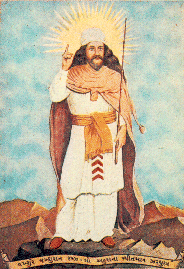| |
|
 |
Zoroastrianism origins
 |
 |
 |
Zarathustra, the founder of the Zoroastrian religion |
The founder Zarathustra
The Zoroastrian religion dates from its prophet Zarathustra, who is reputed to have lived around 1200 BC, though some say 600 BC. He is believed to be the author of the core texts of the Avesta, the main source of Zoroastrian teachings. An Iranian tribal prince became his follower, and so his faith took root and eventually became the state religion of the Persian Empire whose priests were the famed magi. Its doctrines influenced among others the Jews.
Imperial religion
When the Persian Empire was conquered by Alexander the Great in the fourth century BC, much of the Zoroastrian tradition was lost. But later on Zoroastrianism was resurrected as the state religion of the Sassanian Empire and organised with a strong ecclesiastic structure a priesthood, colleges and many temples. The Avesta was compiled into 21 volumes. But only a few copies were made – too few, as it turned out.
The Parsis
During the seventh century Muslim conquests, these few texts were destroyed and Islam became the state religion of Iran, gradually replacing Zoroastrianism throughout the land. Around this time, some Zoroastrians set sail for India where they founded the Parsi (Persian) community in Gujarat. They prospered as farmers and traders while the Iranian community diminished.
Modern diaspora
The Parsi community helped build up Mumbai (Bombay), where they came to form a wealthy and well-educated middle class. With the end of British rule in India, some of these Zoroastrians settled abroad and prospered in the cities of England, Canada, Australia and the USA. Zoroastrians now number only about 150,000 worldwide, of whom the majority live in Mumbai. Other notable communities are in Britain and on the west coast of North America.
|
 |
|
|
|
|
|
 |
What do Zoroastrians believe?
A brief outline of Zoroastrian beliefs |
 |
Parsis recycle flower offerings from Fire Temples
The Zoroastrian Alliance for Religion and Conservation promotes this recycling project in all 47 existing Fire Temples in Mumbai, which has the highest concentration of Zoroastrians |
 |
24 June 2008 :
Catholic Schools Eco Newsletter No.4
How one school celebrated earthday with a full timetable "crash" with every lesson dedicated to the earth, including prayer flags, natural dyes, stream cleanup, willow art. The pupils wanted it to be "Earth Day Every Day." |
 |
 |
|
|

